Day 2 of a three day Autumn Migration tour today. It was another sunny day, with wall to wall blue skies. It was warm too, up to 22C in the afternoon, but there was a rather nagging blustery ESE wind which possibly kept some of the smaller birds tucked down today.
We started the day at Wells. As we got out of the minibus, the first bird we saw was a Great White Egret out in the grass to the left of the track. It was obviously big, with a long snake-like neck. It flew across to the back of the pool and started working its way along the edge. Through the scope, we could see its long, yellow, dagger-shaped bill.

We scanned the pool to the east. We were looking into the light, but we could see lots of Black-tailed Godwits gathered in the water over towards the back. Several Ruff were feeding on the muddy edges of the water.
There were lots of ducks too, mainly Wigeon and Teal returned for the winter, sleeping in the shallow water. Two Pintail were swimming nearby. The drakes are still in their drab eclipse plumage, lacking the very long pin-shaped tail feathers, but Pintail still show a rather pointed tail in other plumages which is noticeable even at a distance, as well as an elegant silhouette.
There were hundreds of geese in the stubble fields beyond the pools, in front of us and away to the east. From here, we could see mostly Greylags but small groups of Pink-footed Geese kept flying in from the west and dropping down out of sight. It was only later we would see how many Pink-footed Geese were really feeding there.
As we walked down along the track, a Grey Heron flew in across the pool off to the right. It crossed the track and flew straight over towards the Great White Egret, which was still making its way along the edge the other side. As the Grey Heron swept down at it, the Great White Egret took off and flew away towards the saltmarsh. The Grey Heron took over feeding along the back edge.
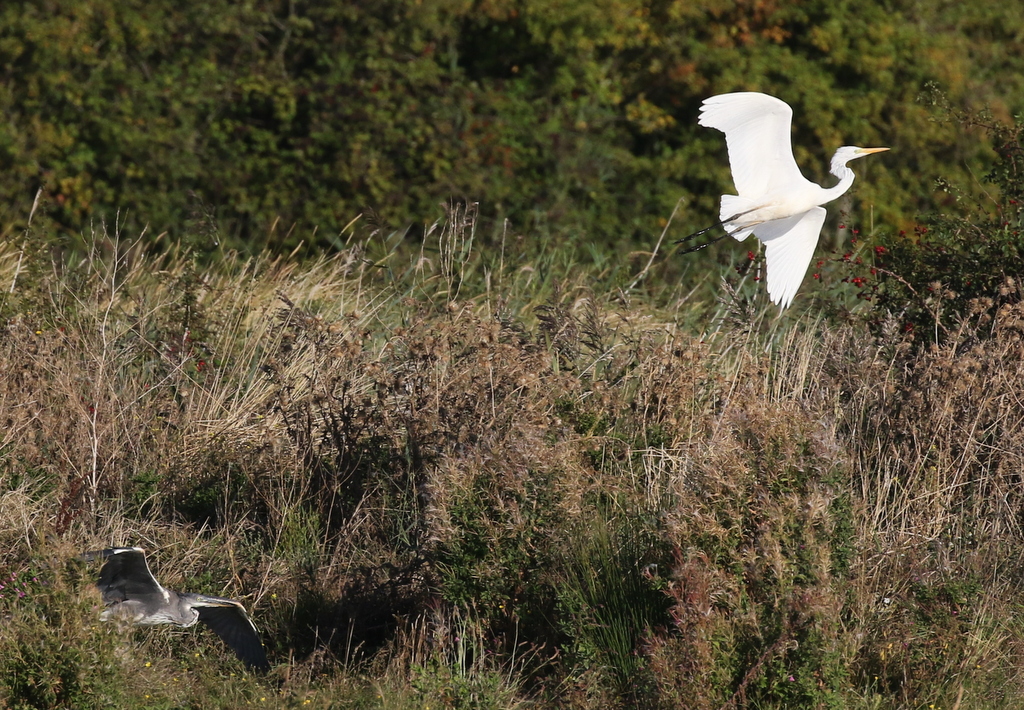
The bushes beyond the pools have been good for warblers in recent weeks, so we carried on down the track to take a look. They were ringing in the bushes today, and the nets were up, so there was quite a bit of disturbance. The wind didn’t help our search either. We heard one or two Chiffchaffs, a couple of Blackcaps and a Lesser Whitethroat calling from deep in the bushes as we walked round. A small group of Greenfinches flew out calling, and we found a few Blue Tits.
Over towards the western edge, where it was a bit quieter and a bit more sheltered we managed to find a few more birds. There were lots of Goldfinches in the hawthorns together with a couple of Reed Buntings. Two male Blackcaps appeared in the brambles and we were able to get a good look at them feeding there in the scope.
From up on the seawall, we scanned the saltmarsh out towards Wells harbour. There were a few Oystercatchers and Redshanks on the mud, and Curlews well camouflaged in the vegetation. A flock of Linnets whirled round and dropped back down onto the saltmarsh. A Swallow flew past – a migrant on its way to Africa for the winter.
We had a look at the westernmost pool from up on the bank. There were plenty of Teal asleep in the short grass, along with a few Mallard, and yet more Greylags. A couple of Common Snipe were feeding in the mud. A Common Buzzard was perched on a bush over the back.
As we started to make our way back, several thousand geese came up from the stubble fields away to the east. They were mostly Pink-footed Geese – we could hear their yelping calls. Most flew up and headed out towards the saltmarsh, but a few circled round above us. The Greylags came up from the fields too, but flew over much lower and dropped down on the pools.
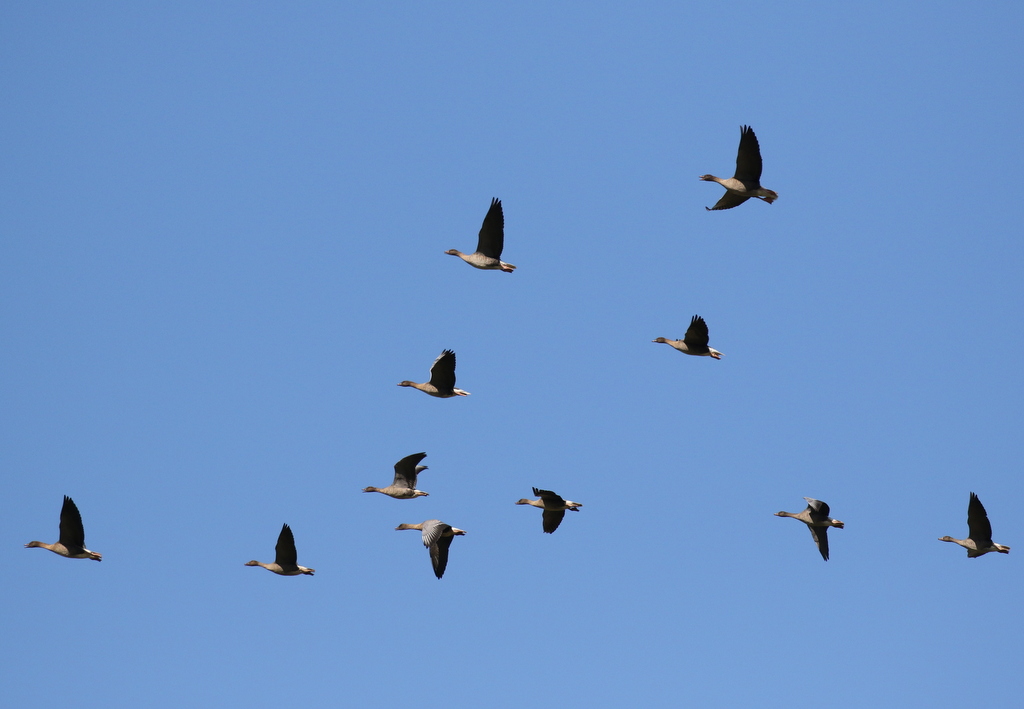
A Jay flew in determinedly from the east and we watched it disappear west all the way to Wells. Then as we walked back up the track past the pools, we looked across to see another flock of at least eight Jays come out of Wells and disappear inland over the ridge behind the town. They were on the move again today. Almost back to the minibus, a Yellowhammer came up in the bushes by the track. It flew over and landed in the top of a hawthorn, where we could get it in the scope.
We made our way east along the coast road to Cley next. We parked by Walsey Hills and had a quick walk in along the footpath to see if we could find any migrants in the trees. Even though it was a bit more sheltered in here, it was fairly quiet apart from the hum of bees around the ivy flowers. There were a few Blue Tits and a Great Tit around the feeders, and a brown-headed young Blackcap in the bushes. A Cetti’s Warbler shouted from the willows at the back. We heard a Rook calling and looked up to see it chasing a Kestrel high overhead in the blue sky, in an aerial duel that still seemed to be ongoing when we looked up again a few minutes later.
Across the road, we made our way up along the East Bank. There were a couple of Little Grebes on Don’s Pool, diving in the blanket weed. Several Common Darters were basking on the path ahead of us, sheltered from the wind by the taller vegetation along the edges. With the wind blowing the reeds about there was no sign of anything out in the reedbed today.

The grazing meadows are looking very dry now, and the three Grey Herons and two Little Egrets were gathered by one of the main ditches across the middle which still has water in it. Whether it was the cattle standing around the Serpentine, of the fact that it too is now starting to dry out, there were no waders at all on here today. There were lots of Pied Wagtails and Meadow Pipits running around on the dried mud around the cows’ feet. A single Wheatear was on the top of the bank at the back of the Serpentine – another migrant stopping off on its way south.
Continuing on to Arnold’s Marsh, there were still four Sandwich Terns on one of small islands towards the back. There had been a couple of Curlew Sandpipers out here recently, but there was no sign today, just three Dunlin, as well as several Redshanks and a few Curlew. Lots of Cormorants had come in from the sea to loaf and dry their wings.
When we got out to the beach, we could see one or two Gannets passing by offshore. A couple of Red-throated Divers flew past distantly, before someone picked up one on the sea closer in. It was an adult still in breeding plumage, and it was just possible to see its red throat when it turned and caught the light. A second Red-throated Diver was also on the sea further over, and a Guillemot zipped past in a whirr of wings.
As we turned to walk back, we spotted another Wheatear on the shingle beyond the fence behind us. We watched it through the scope before it flew and dropped over the edge out of view. As we got back towards the road, a rather tatty Red Kite was hanging in the wind over North Foreland wood.
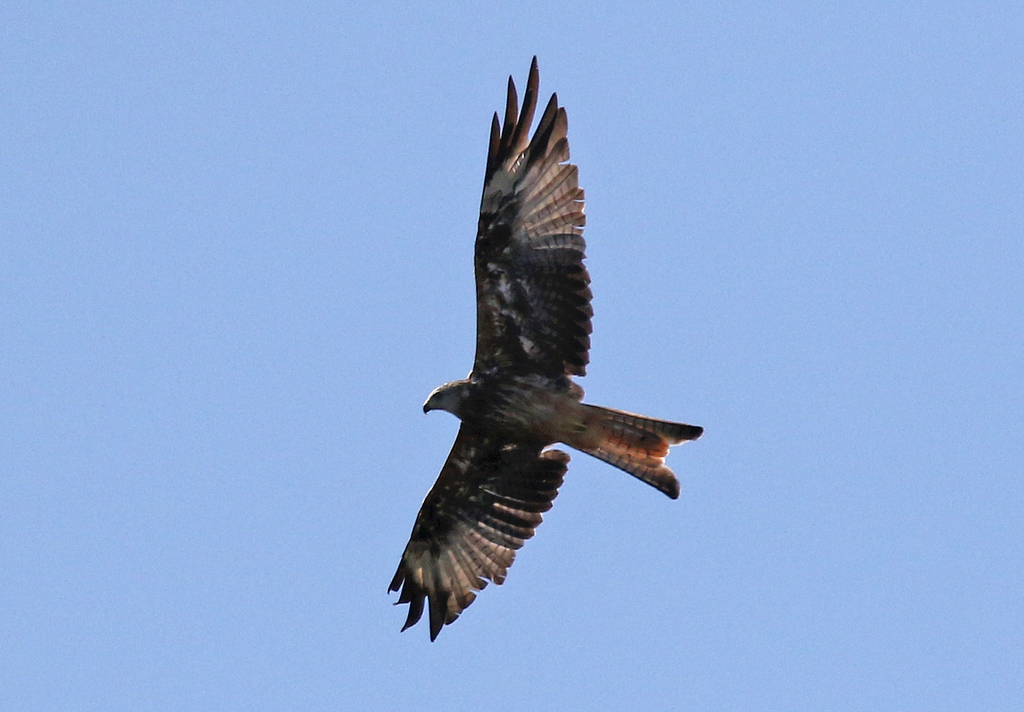
We stopped for lunch back at the Visitor Centre and took the opportunity to look at the Bird Photographer of the Year exhibition in the education centre. After lunch, we decided to have a look out from the hides.
There had been a couple of things reported on Simmond’s Scrape this morning, so we headed out to Dauke’s Hide first. As we walked in, we could see a Green Sandpiper feeding on the mud right in front. A great view and a new wader for the trip list.
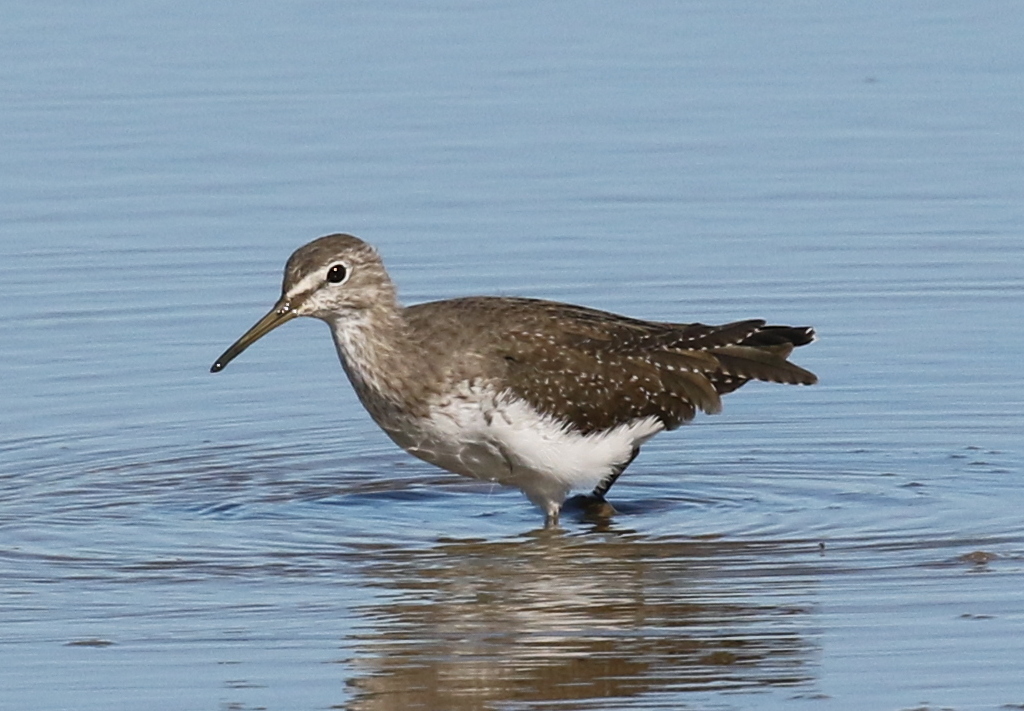
There were lots of Dunlin scattered around the scrape busy feeding, so we started to look through them to see if we could find the Curlew Sandpiper. But before we could, something spooked them and they all flew off.
A dusky grey juvenile Spotted Redshank was feeding in the far corner and when it came out into the water where we could see it, we got a good look through the scope at its long dagger-shaped bill, and could even see the small downward tweaked tip.
Twenty juvenile Bar-tailed Godwits dropped in with a flock of about thirty Curlews, possibly fresh arrivals back from the continent for the winter. We got the scope on some Black-tailed Godwits which were out on Pat’s Pool to compare, much plainer grey-brown backed now in non-breeding plumage. Two Greenshank flew in calling, and landed on the near edge of Pat’s Pool too.

We could see all the Dunlin were round on the other scrape too now, so we walked round to Teal Hide to have another go at finding the Curlew Sandpiper. The Dunlin were all feeding along the back edge against the reeds, and scanning through carefully we quickly found the Curlew Sandpiper with them. But before we could all get a look at it through the scope, the birds all spooked again and we watched as they flew back over to Simmond’s Scrape.
We followed them, back to Dauke’s Hide, and this time we managed to get good prolonged view of the Curlew Sandpiper feeding along the back edge. It was feeding with the Dunlin at times, so we could see it was a little bigger, with a slightly longer bill. It was a juvenile, white on the belly, with a peachy wash on the breast and scaly back. Amazing to think that it was born this summer right up in central Siberia and is making its own way down to Africa.
The two Greenshank were on here too now, and the Spotted Redshanks had multipled. One juvenile was feeding with a Common Redshank at the back, but the original bird was now making its way along the edge of the scrape towards us, much closer than it had been.
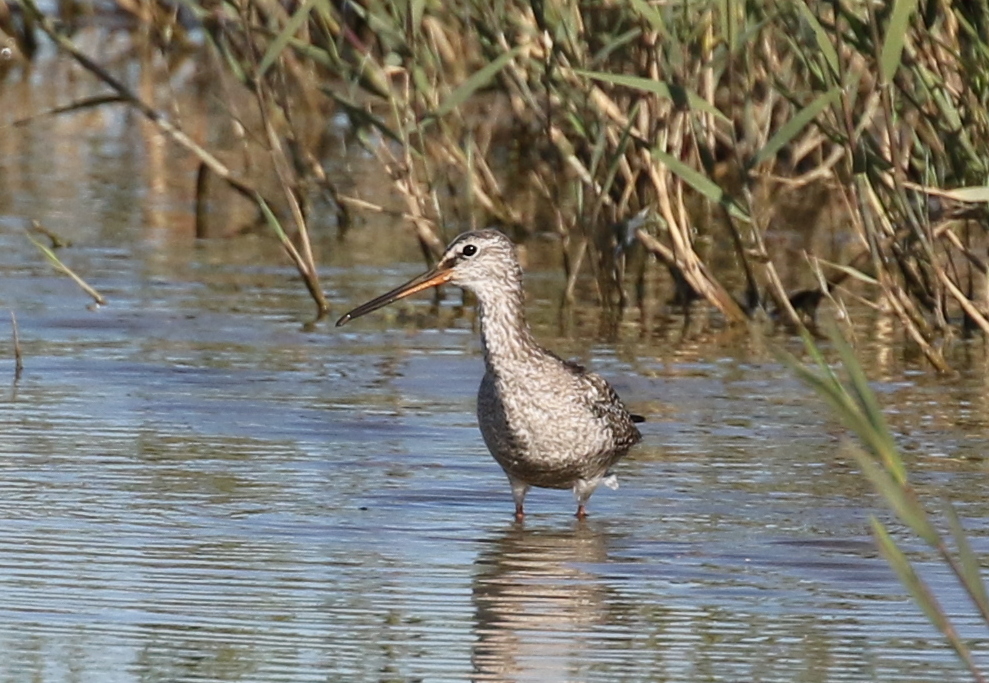
A Kingfisher shot in over the water, turned over the ditch and flew across right in front of the hide. If you weren’t quick, you missed it, but the Kingfisher then helpfully flew back the other way, looped round over the scrape and did a third pass right in front in a flash of electric blue.
As we made our way back to the car park, we could hear a Grey Partridge calling from somewhere out on the grazing marsh, behind the reeds. One of the highlights of this time of year is the autumn gathering of Stone Curlews down in the Brecks, and it seemed a good opportunity to escape the breezy conditions on the coast and head inland to see if we could find them.
It is a bit of a drive down to the Brecks, but everyone agreed it was well worth it. As soon as we got out of the minibus, we could see one Stone Curlew out in the bare field ahead of us. It was settled down just over a ridge initially – we could still see its head and back, its bright yellow iris and short black-tipped yellow bill. It stood up and walked a short distance across the field – the light was perfect, low behind us, and its yellow legs shone in the sunshine.
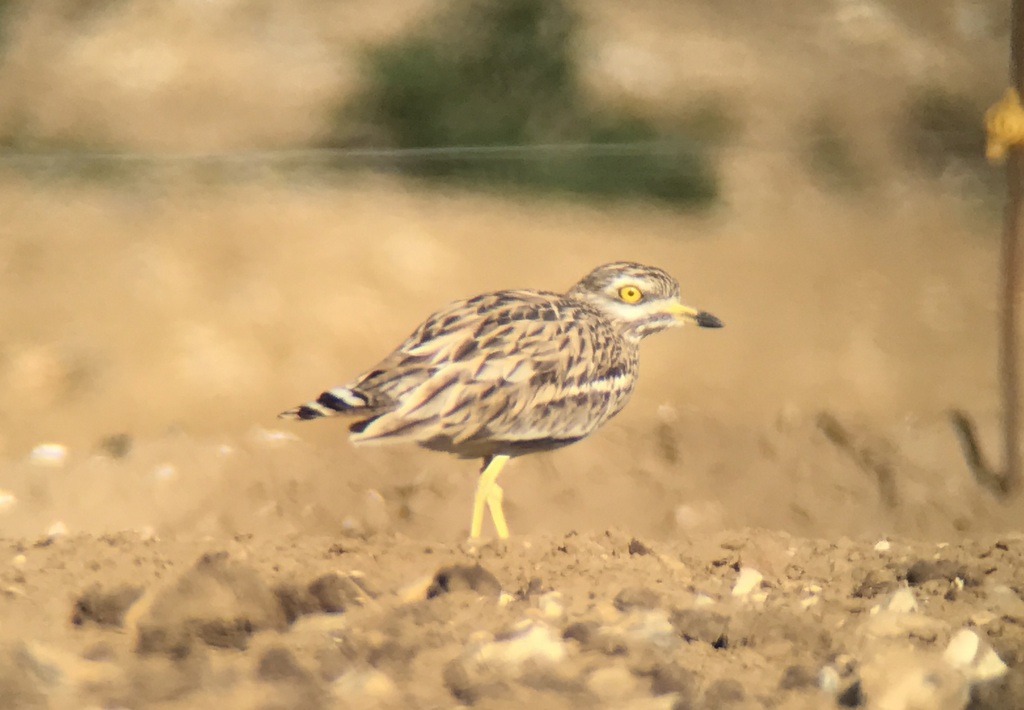
Scanning the field, we realised we could see more Stone Curlews further back, mostly settled down behind clumps of vegetation or small banks of earth. The more we looked, the more we found. Three more Stone Curlews flew in and landed out in the middle. Another four ran out from where they were hidden and joined the first one we had seen. There were at least twenty we had seen now and probably many more hidden where we still couldn’t see them. But we had great views of the nearer ones!
A Tree Sparrow was calling from the thick hedge away along the edge of the field, but we couldn’t see it. Six Common Buzzards circled up over the trees at the back, and two Red Kites closer to us. It was a great way to end the day, with the Stone Curlews becoming more active the later it got, but we had to tear ourselves away and head back.
















